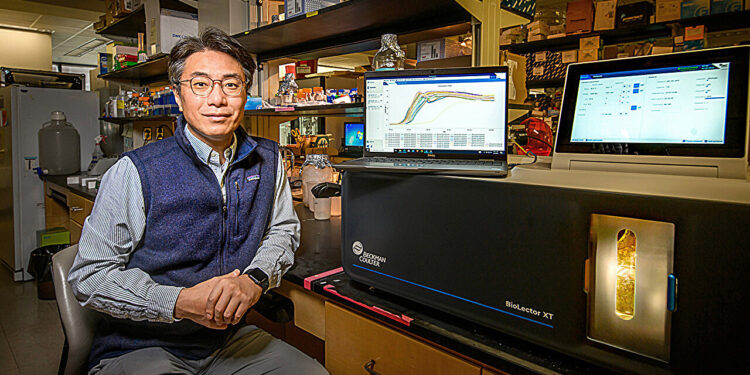A research team jointly led by food science and human nutrition professor Yong-Su Jin, pictured here, with bioengineering professor Ting Lu, not pictured, has found a way to increase ethanol production to from a mixture of sugars using a microbial division of labor. mathematical approach and modeling. Credit: Fred Zwicky
Scientists have found a way to increase ethanol production via yeast fermentation, a standard method for converting plant sugars into biofuels. Their approach, detailed in the review Natural communications, relies on careful timing and close division of labor between synthetic yeast strains to produce more ethanol per unit of plant sugars than previous approaches have achieved.
“We constructed an artificial microbial community composed of two engineered yeast strains: a glucose specialist and a xylose specialist,” said Yong-Su Jin, professor of food science and human nutrition at the University of Illinois. in Urbana-Champaign, who co-led the new research with U of I bioengineering professor Ting Lu. “We studied how the timing of mixing the two yeast populations and the ratios in which the two populations were mixed affected the production of cellulosic ethanol.”
Postdoctoral researchers Jonghyeok Shin and Siqi Lao, Ph.D. student at the Center for Biophysics and Quantitative Biology at the University of I., carried out the work.
Glucose and xylose are the two most abundant sugars derived from the degradation of plant biomass such as agricultural waste. The team was trying to solve a common problem that arises when using yeast to convert these plant sugars into ethanol. In nature, the yeast strain of interest, Saccharomyces cerevisiae, prefers glucose and lacks the ability to metabolize xylose. Other scientists have used genetic engineering to modify yeast so that it also consumes xylose, but these modified strains still prefer glucose, reducing their overall efficiency in producing ethanol.
Some scientists have pursued the idea that communities of microbes, each with its own particular function, can function more efficiently than a single, highly sophisticated strain.
“My group is dedicated to the design, analysis and engineering of synthetic microbial communities. Jin’s lab specializes in yeast metabolic engineering and biofuel production,” Lu said.
“Our complementary expertise allowed us to test whether a division of labor approach between yeasts could work well in biofuel production.”
The researchers conducted a series of experiments testing the use of their two specialized yeast strains. They changed the order in which the different strains were added to the sugar mixture as well as the timing of each addition.
“We also studied the ratios in which the two populations were mixed to determine their effects on the rapid and efficient production of cellulosic ethanol,” Jin said.
The team also developed a mathematical model that accurately predicts their yeast performance and ethanol yields.
“We used data from the experiments to train our mathematical model to capture characteristic ecosystem behaviors,” Lu said. “The model was then used to predict optimal fermentation conditions, which were then validated by corresponding experiments.”
The researchers found that first adding the xylose-fermenting yeast specialist to the mixture, followed 14 to 29 hours later by the glucose specialist, significantly increased ethanol production, doubling the yield.
“This study demonstrates the functional potential of division of labor in bioprocessing and provides insight into the rational design of engineered ecosystems for diverse applications,” the authors wrote.
Yong-Su Jin and Ting Lu are also professors in the area of biosystems design at the Carl R. Woese Institute for Genomic Biology at U of I. Jonghyeok Shin is now a scientist at the Korea Research Institute of Bioscience and Biotechnology.
More information:
Jonghyeok Shin et al, Compositional and temporal division of labor modulates the fermentation of mixed sugars by a consortium of artificial yeasts, Natural communications (2024). DOI: 10.1038/s41467-024-45011-w
Provided by University of Illinois at Urbana-Champaign
Quote: Microbial division of labor produces higher yields of biofuels (February 5, 2024) retrieved February 5, 2024 from
This document is subject to copyright. Except for fair use for private study or research purposes, no part may be reproduced without written permission. The content is provided for information only.



